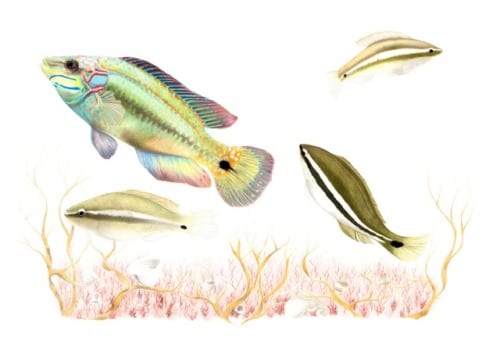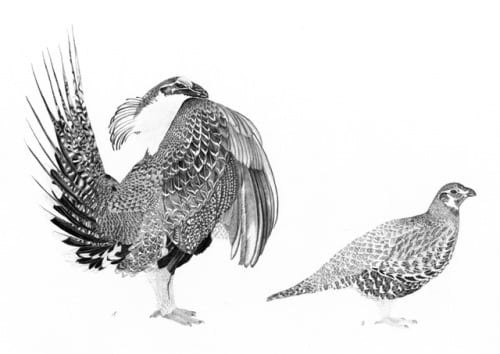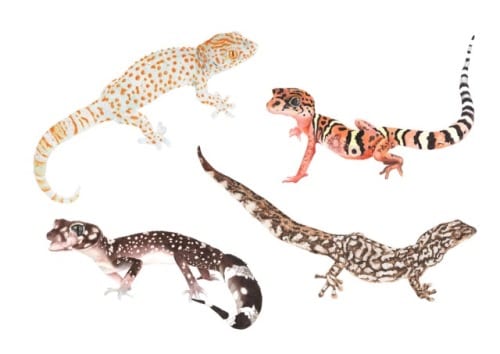Natural Creativity: Sex and Trickery opens at the Grant Museum
By Jack Ashby, on 18 October 2016
‘Natural Creativity: Sex and Trickery’ is our new exhibition – opening tomorrow 19th October – at the Grant Museum. It explores the myriad of elaborate shapes, sizes and crafty behavioural tactics some animals have evolved in order to survive, reproduce and pass on their genes.
Through intricate drawings by the artist Clara Lacy, ‘Natural Creativity’ asks the question, why is the natural world so colourful and varied? Lacy has drawn species with highly unusual sexual behaviours or mechanisms for determining sex. It is commonly assumed that animals are born either male or female then reproduce as adults, but things can get much more interesting. Some species change sex over their lifetime, become a grandmother before giving birth, or trick others into thinking they belong to the opposite sex.

Ocellated wrasse (C) Clara Lacy.
The ocellated wrasse has an unusual mating system – different males use different strategies in the attempt to pass on their genes. The genetics of these strategies is being researched at UCL. “Nesting males” are brightly coloured and work to court females, defend nests and care for their young. These males attract the most females, but other males have evolved different routes to mating success.
Small males become “Sneakers”. They surreptitiously approach Nesting males and females while they are mating, and then release their own sperm into the water.
Medium-sized “Satellite males” cooperate with a Nesting male, helping them chase Sneakers from the nest. This means that they are tolerated by Nesting males, and spawn while the Nesting male is mating.
Sneaky males and choosy females
Some of the artworks feature species of birds and fish whose males have evolved elaborate colours and absurd ornamental appendages to attract mates. These resplendent males will attack any rivals they see approaching. However, some smaller males develop colourings that make them look like females, so they can sneak past the dominant male and get a share of the females themselves.
In many species, such as orangutans and grouse, the males grow to be several times bigger than the females, coming to blows to fight off their rivals. Male Darwin’s beetles have evolved massive jaws which are longer than the rest of their bodies and used to throw their competitors out of the tree. In other species the preferences of the females for ostentatious colours and courtship rituals have driven the males to develop ridiculous appearances and behaviours, in order to catch the fancy of their potential mates.

Greater sage grouse (C) Clara Lacy
Sage-grouse are North America’s largest species of grouse, and show the greatest differences between the males and females. The males are nearly twice the size of females, while the sexes differ little in other, smaller grouse species.
Only a small number of males get the opportunity to breed. Females select the most attractive males based on an elaborate courtship displays. The males puff up large air sacks on their chests, make a drumming noise and flaunt their tail feathers in an attempt to attract mates.
The art of science
The species in the exhibition are the focus of research into the evolution of sexual behaviour, preferences and the ways that sex is determined in animals. Clara Lacy is the Artist in Residence in the Mank Lab at UCL’s Department of Genetics, Evolution and Environment. Working closely with the scientists based there, Lacy’s illustrations bring to life their research into the amazing variety of sexual and genetic survival strategies in the animal kingdom.
This project is really exciting as it allows us to explore extremely modern advances in modern zoology taking place here at UCL. We can engage with them through stunning, intricate drawings displayed among our historic specimens. As well as that, some of the things these animals are doing to reproduce is genuinely jaw-dropping. Evolution has a lot to answer for.

Geckos (C) Clara Lacy
The mechanisms by which sex is determined vary hugely across the animal kingdom. This diversity is exemplified by geckos, a group of 1500 species of lizard with remarkable variation in the ways individuals become male or female.
The Yucatan banded gecko from Mexico has XY sex chromosomes where the Y chromosome is present only in males. By contrast, the Australian thick-tailed gecko has ZW sex chromosomes where the W is found only in females.
In other geckos, the temperature at which an individual is reared determines whether they develop into a male or a female. Researchers at UCL are studying geckos to understand what drives this remarkable diversity in sex determination and to compare sex chromosome evolution across different species.
‘Natural Creativity: Sex and Trickery’ runs from 19th October to 23rd December 2016. The Grant Museum of Zoology is open from 1–5pm Monday to Saturday. Admission is free and there is no need to book.
Jack Ashby is the Manager of the Grant Museum of Zoology
 Close
Close

